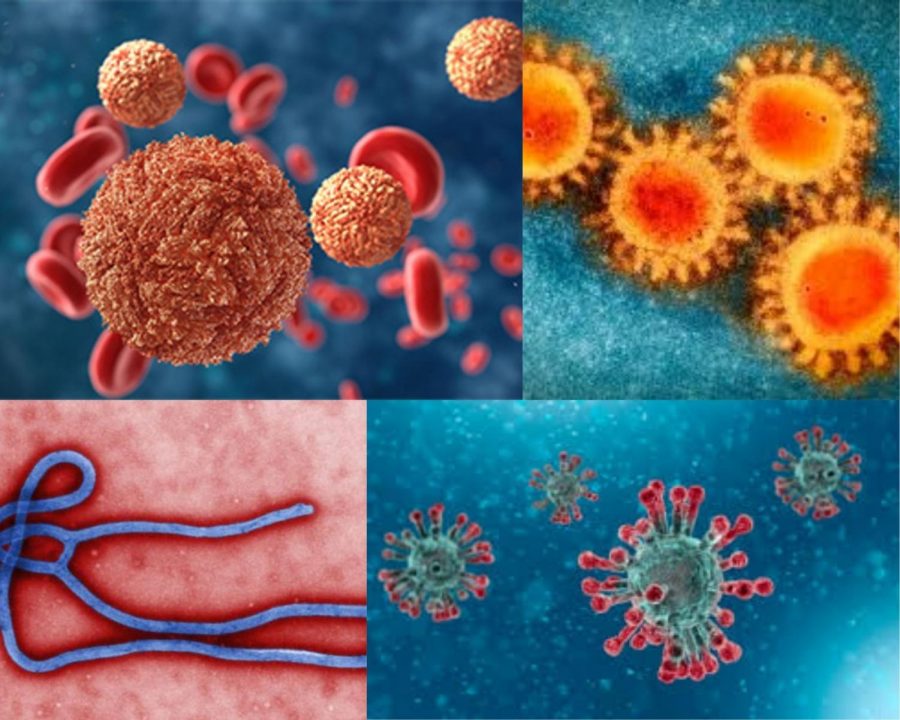Deadliest outbreaks of the last 20 years
Courtesy of European CDC, Medical News Today, The Guardian, and the CDC
Within the last two decades, the world saw the deadliest epidemics— from the Zika virus to the current everchanging Coronavirus. These global pandemics caused hundreds of thousands of deaths, generating fear in the US and surrounding countries. Currently, as the globe deals with the chilling realities of COVID-19, schools, businesses and the overwhelmed health care system prepare to defend themselves from the deadly pandemic.
March 24, 2020
From Ebola to Coronavirus, the world witnessed a number of infectious diseases in the last two decades. Citizens, despite the paranoia, have taken necessary precautions by closing businesses and schools, as deadly plagues wreak havoc on their daily lives. These diseases, which originate from foreign, unknown animals and pre-existing viruses, continue to plague the world, creating global pandemics.
The series of deadly outbreaks in the 20th century began with the infamous SARs (Severe Acute Respiratory Syndrome) with the first case in November of 2002. The syndrome plagued the continent of China first and spread worldwide within the first months of its existence. The disease spreads when microscopic droplets enter the air after someone sneezes or coughs. Those affected felt an increased tension within their respiratory system along with fever, dry cough, headache, muscle aches and difficulty breathing. After its spread, China’s most qualified physicians worked tirelessly to contain the virus and prevent additional spreading.
After the SARs epidemic, the H1N1 flu plagued the globe with 18,500 deadly cases in the world in 2009. It originated from the swine flu, a disease found in pigs as a recombinant form of flu in birds and humans in the late 1980s. The H1N1, initially seen in Mexico in April 2009, contained a mix of three different strains. Six of the genes, similar to the H1N2 influenza virus, were found in pigs around 2000. According to the National Library of Medicine, the later emergence of the H1N2 heightened public awareness for the potential of virus mutation.
In Haiti, citizens dealt with the chilling reality of a cholera outbreak at the beginning of 2010. Known for its life-threatening dehydration and eventual death when left untreated, Haitians struggled to keep adults and children alive due to poor medical assistance and resources. The outbreak killed over 10,000 Haitians and hindered efforts toward rebuilding the country after natural disasters and violence.
After the observance of yet another Haitian travesty, the country of Africa reported the deadly Ebola virus, which killed nearly 30,000 in 2014. Although the Ebola virus first appeared in 1976, its severity did not escalate and locals remained unaware of its toxicity. The perspective shifted after the virus affected Liberia, Guinea, Sierra Leone, Nigeria, the US and Mali. Ebola consists of a series of intense, deadly symptoms creating a domino effect within the body’s normal functions.
According to WebMD, “The virus causes fever, body aches, and diarrhea, and sometimes bleeding inside and outside the body. As the virus spreads through the body, it damages the immune system and organs. Ultimately, it causes the level of blood-clotting cells to drop. This leads to severe, uncontrollable bleeding.”
“Ebola was a very serious pandemic. It killed hundreds of thousands of innocent people, and in some ways, it had more severe symptoms than corona,” NC Sophomore Tiffani Eliott said.
The Zika virus plagued the country of Uganda in the early 1950s, reappearing in 2015. The virus, which causes no symptoms, primarily affects small infant children, causing the child to have a smaller than average skull. Branching from microcephaly, pregnant women experienced an increased fear of the risks that the Zika virus invokes. This includes a smaller, underdeveloped brain making it harder to process and comprehend basic information. After months of its prominence, the virus spread to the US, scaring new parents and worrying those who wanted children.
Although the virus still affects thousands of young infants, its effects in no way compare to the current Coronavirus. Today, millions of schools, businesses and local facilities remain shut down to prevent the spread of the deadly Coronavirus. Created from an unknown animal in China, the disease spread across the world, causing global panic. Those affected do not typically see symptoms until after two weeks of having the virus, a time limit for most schools and businesses. The symptoms include runny nose, sore throat, cough, fever and in the severest cases, difficulty breathing. Media and news outlets continue to cover the events, with citizens taking precautions as cases unfold.
“The Coronavirus has affected a number of outlets. It has closed many businesses and communities, especially the stock market decreasing due to trade and shipment hindrances from China to the US,” Eliott said.
The last 20 years brought a number of horrendous, deadly viruses that plagued the world and caused an unknown sense of fear. The tactics in containing the diseases continue to evolve as the Coronavirus makes headway in the US. As schools and businesses remain closed, citizens use the time to reflect and contemplate the necessary action they plan to take. What diseases will spread in the next 20 years?




















Samuel • Mar 24, 2020 at 7:06 PM
I liked this and it was very good. Great writing writing as usual